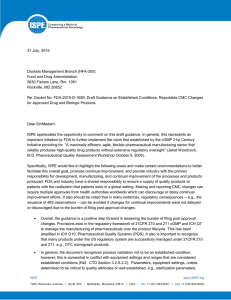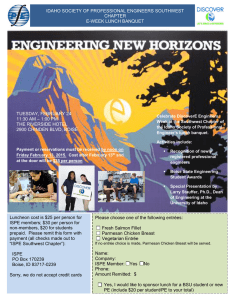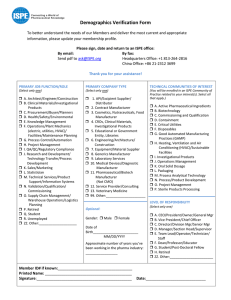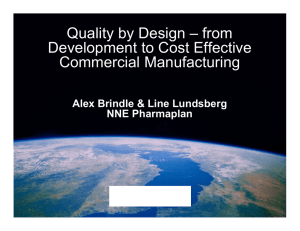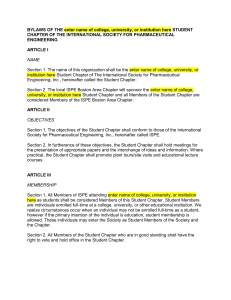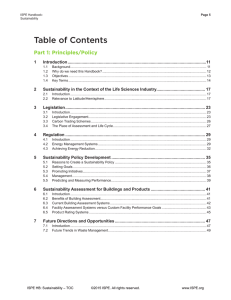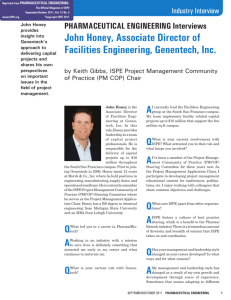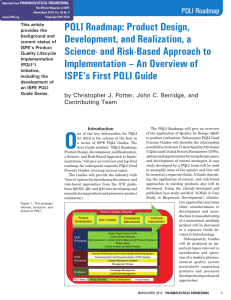Document 11427299
advertisement
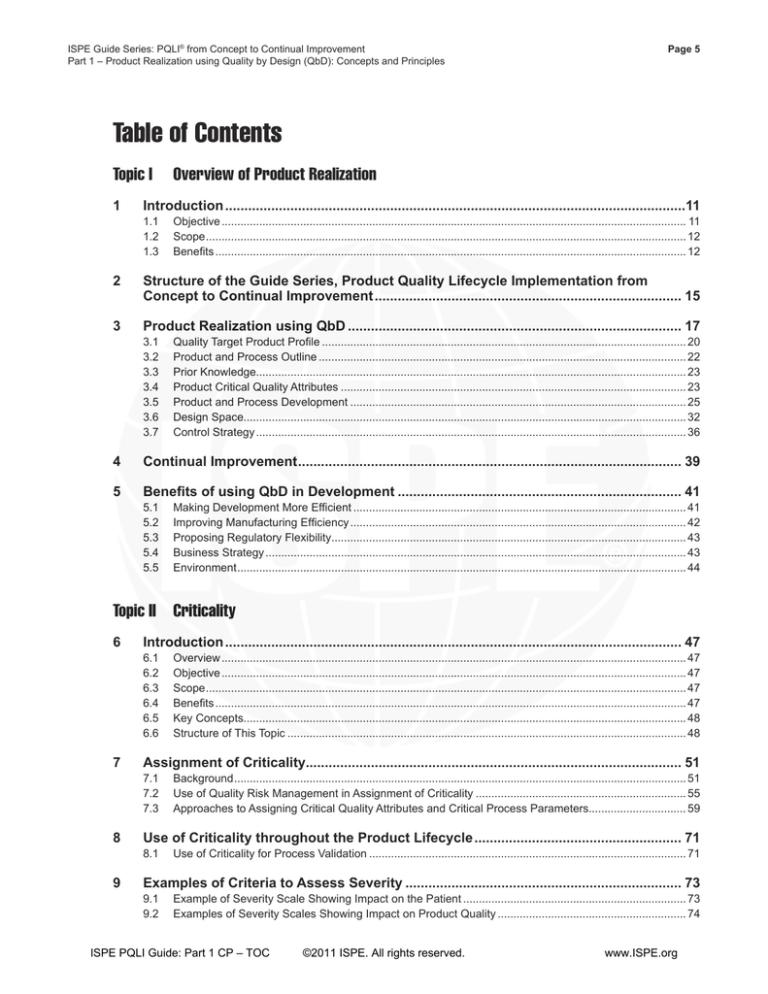
ISPE Guide Series: PQLI® from Concept to Continual Improvement Part 1 – Product Realization using Quality by Design (QbD): Concepts and Principles Table of Contents Topic I Overview of Product Realization 1 Page 5 Introduction.........................................................................................................................11 1.1 Objective..................................................................................................................................................... 11 1.2 Scope.......................................................................................................................................................... 12 1.3 Benefits....................................................................................................................................................... 12 2 Structure of the Guide Series, Product Quality Lifecycle Implementation from Concept to Continual Improvement................................................................................. 15 3 3.1 3.2 3.3 3.4 3.5 3.6 3.7 4 Continual Improvement..................................................................................................... 39 5 Topic II Criticality 6 7 8 9 Product Realization using QbD........................................................................................ 17 Quality Target Product Profile..................................................................................................................... 20 Product and Process Outline...................................................................................................................... 22 Prior Knowledge......................................................................................................................................... 23 Product Critical Quality Attributes............................................................................................................... 23 Product and Process Development............................................................................................................ 25 Design Space............................................................................................................................................. 32 Control Strategy.......................................................................................................................................... 36 Benefits of using QbD in Development........................................................................... 41 5.1 5.2 5.3 5.4 5.5 Making Development More Efficient........................................................................................................... 41 Improving Manufacturing Efficiency............................................................................................................ 42 Proposing Regulatory Flexibility................................................................................................................. 43 Business Strategy....................................................................................................................................... 43 Environment................................................................................................................................................ 44 Introduction........................................................................................................................ 47 6.1 6.2 6.3 6.4 6.5 6.6 Overview..................................................................................................................................................... 47 Objective..................................................................................................................................................... 47 Scope.......................................................................................................................................................... 47 Benefits....................................................................................................................................................... 47 Key Concepts............................................................................................................................................. 48 Structure of This Topic................................................................................................................................ 48 Assignment of Criticality.................................................................................................. 51 7.1 Background................................................................................................................................................. 51 7.2 Use of Quality Risk Management in Assignment of Criticality.................................................................... 55 7.3 Approaches to Assigning Critical Quality Attributes and Critical Process Parameters............................... 59 Use of Criticality throughout the Product Lifecycle....................................................... 71 8.1 Use of Criticality for Process Validation...................................................................................................... 71 Examples of Criteria to Assess Severity......................................................................... 73 9.1 Example of Severity Scale Showing Impact on the Patient........................................................................ 73 9.2 Examples of Severity Scales Showing Impact on Product Quality............................................................. 74 ISPE PQLI Guide: Part 1 CP – TOC ©2011 ISPE. All rights reserved. www.ISPE.org Page 6 ISPE Guide Series: PQLI® from Concept to Continual Improvement Part 1 – Product Realization using Quality by Design (QbD): Concepts and Principles 10 Examples of Criteria to Assess Probability..................................................................... 75 11 Examples of Criteria to Assess Detectability.................................................................. 77 12 Examples of Target Product Profile and Quality Target Product Profile...................... 79 Topic III Design Space 13 Introduction........................................................................................................................ 83 14 Development of Design Space......................................................................................... 89 15 Design Space Updating/Continual Improvement......................................................... 107 16 Relationship of Design Space to Control Strategy....................................................... 109 17 Examples...........................................................................................................................111 Topic IV Control Strategy 18 Introduction...................................................................................................................... 127 13.1 13.2 13.3 13.4 13.5 13.6 14.1 14.2 14.3 14.4 14.5 14.6 14.7 Overview..................................................................................................................................................... 83 Objectives................................................................................................................................................... 83 Scope.......................................................................................................................................................... 83 Benefits....................................................................................................................................................... 83 Key Concepts............................................................................................................................................. 85 Structure of This Topic................................................................................................................................ 88 Introduction................................................................................................................................................. 89 Objective..................................................................................................................................................... 91 Scope of Design Space Development........................................................................................................ 92 Risk Assessment Procedures..................................................................................................................... 93 Experiment Design..................................................................................................................................... 98 Modeling and Presentation of Design Space.............................................................................................. 99 Design Space Confirmation and Scale Considerations............................................................................ 106 15.1 Capability Analysis.................................................................................................................................... 107 17.1 Example 1..................................................................................................................................................111 17.2 Example 2................................................................................................................................................. 112 17.3 Example 3................................................................................................................................................. 113 17.4 Example 4................................................................................................................................................. 115 17.5 Example 5................................................................................................................................................. 116 17.6 Example 6................................................................................................................................................. 120 17.7 Example 7................................................................................................................................................. 120 17.8 Example 8................................................................................................................................................. 121 17.9 Example 9................................................................................................................................................. 123 17.10Example 10............................................................................................................................................... 124 18.1 18.2 18.3 18.4 18.5 18.6 Overview................................................................................................................................................... 127 Objectives................................................................................................................................................. 128 Scope........................................................................................................................................................ 128 Benefits..................................................................................................................................................... 128 Key Concepts........................................................................................................................................... 129 Structure of this Topic............................................................................................................................... 130 ISPE PQLI Guide: Part 1 CP – TOC ©2011 ISPE. All rights reserved. www.ISPE.org ISPE Guide Series: PQLI® from Concept to Continual Improvement Part 1 – Product Realization using Quality by Design (QbD): Concepts and Principles Page 7 19 Lifecycle Approach to Control Strategy........................................................................ 131 20 Control Strategy Options................................................................................................ 137 21 Implementation of the Control Strategy into Manufacturing....................................... 143 22 Process Analytical Technology and Real Time Release Testing in Manufacturing... 151 23 Control Strategy and Process Validation...................................................................... 159 24 Examples.......................................................................................................................... 165 Appendices 25 Appendix 1 – References................................................................................................ 175 26 Appendix 2 – Glossary.................................................................................................... 179 19.1 Control Strategy throughout the Drug Product Lifecycle.......................................................................... 131 20.1 When to Start Developing and Defining the Control Strategy................................................................... 137 20.2 Factors Influencing the Selection of Control Strategy............................................................................... 138 20.3 Control Strategy and Continual Improvement over the Product Lifecycle................................................ 141 21.1 21.2 21.3 21.4 22.1 22.2 22.3 22.4 22.5 22.6 The Link between Design Space and Control Strategy............................................................................ 143 Implementation of Control Strategy.......................................................................................................... 143 Manufacturing/Site Capabilities................................................................................................................ 146 Documentation of the Control Strategy..................................................................................................... 149 Process Analytical Technology in Manufacturing...................................................................................... 151 Real Time Release Testing and Control Strategy for Solid Dose Manufacturing...................................... 151 Sampling and Acceptance Criteria............................................................................................................ 153 Maintaining Control if Failure of PAT Systems.......................................................................................... 155 Validation/Verification of PAT Analytical Tools for RTRT........................................................................... 156 Process Monitoring................................................................................................................................... 156 23.1 Link Between Enhanced, QbD Approach to Control Strategy and the Lifecycle of Process Validation.... 159 23.2 Continued Process Verification................................................................................................................. 163 23.3 Verification of the Control Strategy........................................................................................................... 163 24.1 24.2 24.3 24.4 Example 1: Establishing a Control Strategy Meeting Business Objectives.............................................. 165 Example 2: Establishing a Control Strategy using PAT and Meeting Business Objectives...................... 167 Example 3: Interaction between Drug Substance and Drug Product for Continual Improvement............ 167 Example 4: Interaction between Drug Product and Excipients for Continual Improvement..................... 169 25.1 References................................................................................................................................................ 175 25.2 Further Reading........................................................................................................................................ 177 26.1 Acronyms.................................................................................................................................................. 179 26.2 Definitions................................................................................................................................................. 180 ISPE PQLI Guide: Part 1 CP – TOC ©2011 ISPE. All rights reserved. www.ISPE.org
